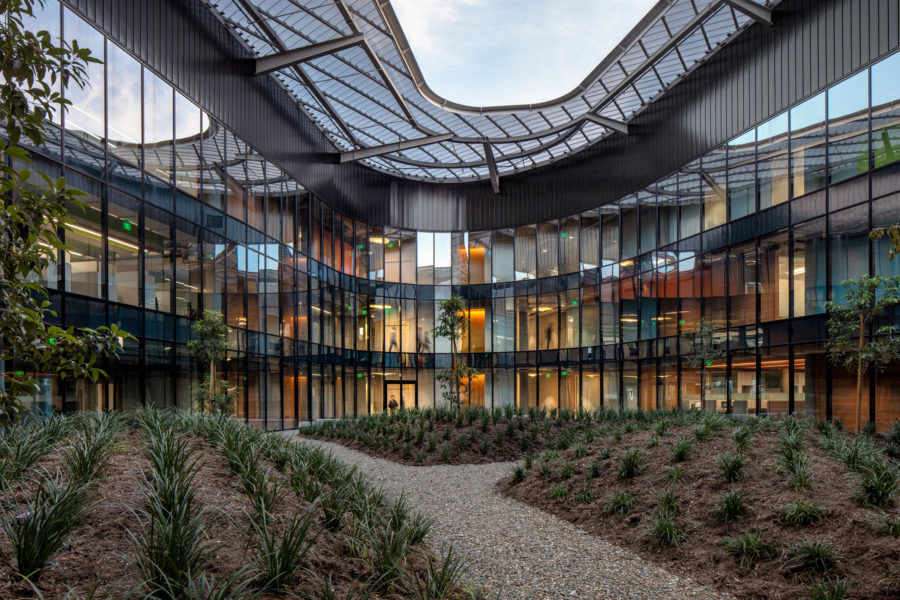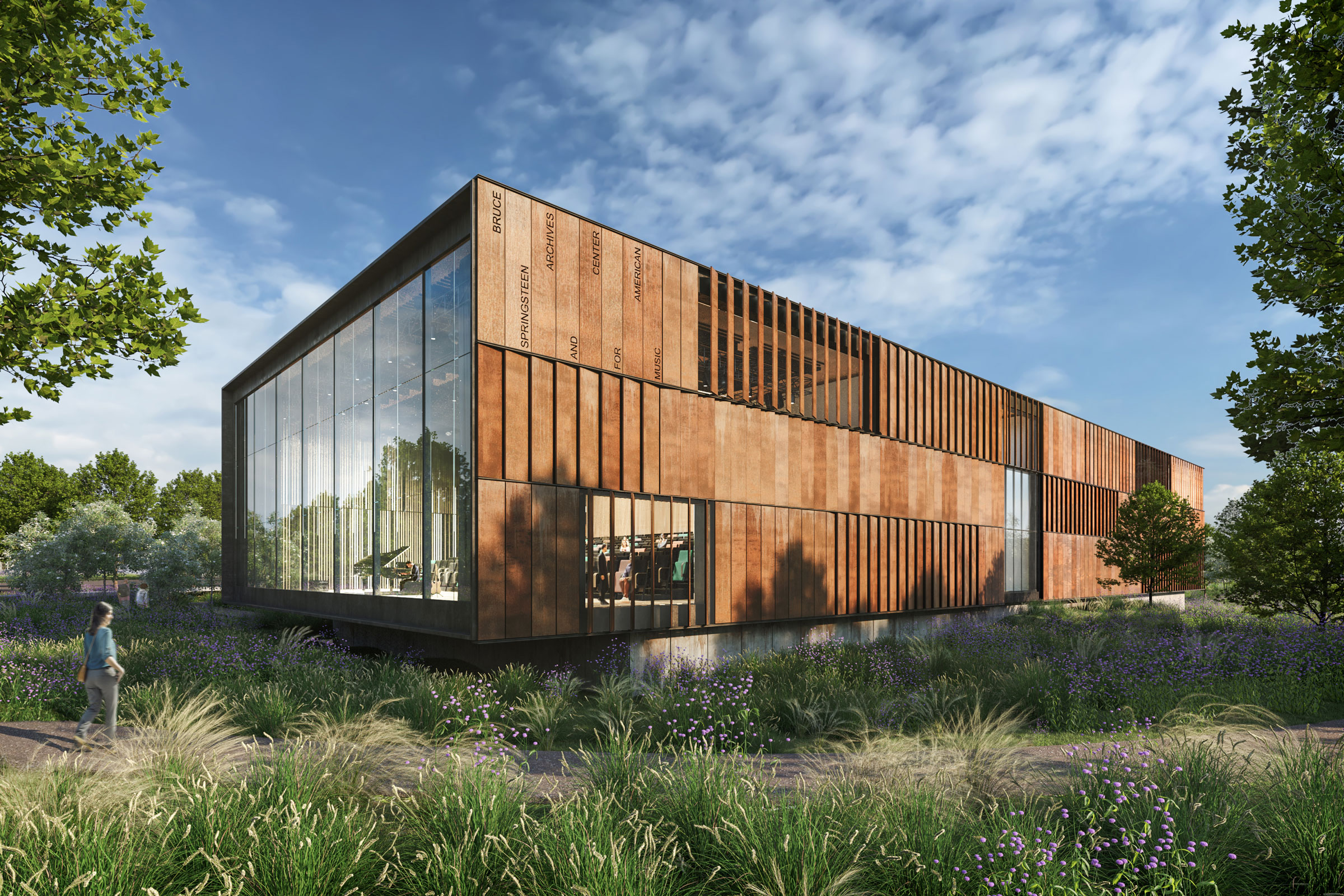Story at a glance:
- A bioswale is an intentionally designed channel used to convey stormwater runoff and filter out pollutants.
- There are four types of bioswales—low grass, vegetated, low water, and wet—each of which are best suited to different environmental conditions.
- Bioswales are ideal in places with a high concentration of impermeable surfaces, such as near roadways, parking lots, sidewalks, and driveways.
Due to their high concentration of impermeable surfaces, it is crucial that cities and other urbanized areas find ways to effectively mitigate and manage stormwater runoff to prevent sewers and stormwater management systems from overflowing. Concrete gutter systems have been the go-to method for transporting runoff away from roads, sidewalks, parking lots, and other hard surfaces for decades—but despite their widespread use, they aren’t the most efficient means of managing runoff, nor are they particularly sustainable.
Bioswales, on the other hand, are much more effective at managing stormwater, thanks to the fact that they both convey runoff and provide permeable surfaces for that runoff to be absorbed into, all while helping to filter out pollutants and recharge groundwater stores.
Here we look at the basics of bioswales, including the different types, how they manage stormwater, the benefits they offer, and ideal locations as well as a few tips on how to maintain bioswales for peak efficacy.
What is a Bioswale?

In this project a dual-purpose decorative metal band channels stormwater and roof runoff to a vegetated bioswale, where the water slowly infiltrates into the site’s capture system. This reclaimed water is used to irrigate the new landscape, unburdening the campus’ potable water system. Photo by Bill Timmerman
A bioswale is a narrow strip of vegetated landscape similar to a ditch that is intentionally designed to convey and treat stormwater runoff before allowing it to soak into the earth and recharge groundwater reservoirs. Bioswales are an aesthetically pleasing and more environmentally friendly alternative to conventional concrete gutters and other hardscaped stormwater management systems.
Bioswales are extremely versatile and may be implemented in almost any region, as their designs can be tailored to suit specific site considerations through the integration of native plant species. Bioswales are most effective at dealing with small, low-intensity rain events but can realistically be engineered to effectively handle almost any sized storm.
Types of Bioswales
There are four distinct types of bioswales—low grass, low water, vegetated, and wet—each of which are best suited to slightly different conditions.
- Low grass. The simplest type of bioswale, low grass bioswales utilize low growing turf grasses that may be landscaped similar to a lawn; generally considered to be the least effective kind of bioswale.
- Vegetated. In contrast, a vegetated bioswale may be planted with a variety of taller grasses, shrubs, perennials, or some combination of all three and typically includes rocks to help further reduce the velocity of stormwater runoff and increase infiltration.
- Low water. A low water bioswale is ideal in climes that experience low rainfall and high temperatures; these bioswales are typically xeriscaped with drought-tolerant plants and only contain runoff after rainstorms, staying dry the rest of the time.
- Wet. As the name suggests, wet bioswales are designed to retain stormwater runoff for much longer periods of time than conventional bioswales, functioning similarly to a stormwater wetland and allowing for higher rates of infiltration.
Each type of bioswale requires different species of vegetation and has slightly different maintenance requirements.
Components of a Bioswale

A bioswale collects rainwater from the roof to water plants. It also allows natural light into the lower level. Photo by Jason Keen
Visually bioswales are incredibly similar to ditches, another type of sloped landscape feature designed to convey stormwater. The difference between the two, however, is in their composition, as bioswales are specifically designed and engineered to be as effective as possible at cleaning and conveying runoff.
The exact composition of a bioswale may vary depending on certain factors, but most consist of the following elements:
- Vegetation. The top layer of a bioswale is dedicated to the growth of dense, tightly-packed vegetation that provides a high surface area for stormwater contact; this layer of vegetation serves to both reduce the velocity of runoff and filter out pollutants by way of phytoremediation.
- Engineered soil. The plants in a bioswale are grown in an engineered soil mixture appropriate to the site and regional context; exact soil composition will vary but typically consists of around 60% sandy loam and 40% compost to facilitate proper drainage and treatment.
- Aggregate. Underneath the engineered soil is a layer of gravel, scoria, or baked-clay pellets that are then enclosed and packed with geotextile; these aggregate materials do not compact but create many empty voids through which water is able to drain.
- Underdrain. An underdrain or infiltration pipe is a perforated tube located within the aggregate layer that collects water as it is filtered and transports it away from the main channel.
- Bypass drains. Many bioswales also feature bypass drains, or above-ground drainage features that connect to the below-ground underdrain; bypass drains are designed to prevent bioswales from overflowing their banks during periods of heavy rainfall.
- Filters. Bioswales include filters to ensure that inlets and outlets do not become blocked by sediments, debris, or trash that would otherwise cause water to pool and stagnate.
Many bioswales also contain check dams, or small dams typically constructed from rocks that help prevent erosion by reducing the velocity of runoff as it flows through the channel. Rocks can also be positioned at the entrance of bioswale inlets to act as energy dissipators and reduce the flow of water. By counteracting erosion and lessening the flow-rate, check dams and other energy dissipators ultimately increase the functional longevity of bioswales and improve the rate of stormwater infiltration.
Bioswale Design Considerations
Bioswales may appear relatively simple in their design, but the truth is that each and every aspect about them is carefully engineered to maximize their ability to efficiently manage stormwater. The following design considerations are crucial to the creation of effective bioswales:
- Plant selection. When selecting plants for a bioswale, dense species endemic to the region—such as native perennial grasses—are recommended; plants that are selected for bioswale use should always be taller than the ponding depth to ensure runoff is filtered effectively.
- Soil composition. The engineered soil mixture or planting medium used in a bioswale should contain no more than 5% clay and must allow for 5 to 10 inches of rainwater infiltration per hour.
- Longitudinal slope. The longitudinal slope—or downward slope in the direction of flow—of a bioswale determines runoff velocity and is partially responsible for the rate of infiltration; the minimum longitudinal slope is 1% and the recommended maximum is 4% (check dams should be implemented in cases where the slope exceeds 4%).
- Side slope. The sides of a bioswale should conform to a trapezoidal or parabolic shape and should not exceed a slope ratio of 4:1; this helps to increase infiltration and treatment of stormwater by expanding the wetted perimeter.
- Sizing. It is recommended that a bioswale be at least 100 feet long with a 3-foot bed width to ensure adequate performance; exact sizing and dimensions will ultimately depend on site-specific application needs, but the bioswale’s surface area should be equal to or greater than 1% of the entire drainage area.
- Ponding depth. It is recommended that the maximum ponding depth be limited to approximately six inches to facilitate efficient infiltration.
- Clearance. Unless constructing a wet bioswale, a 5-foot minimum clearance should be maintained between the bottom of the swale and the top of the seasonal high groundwater table to facilitate proper drainage and avoid oversaturation.
- Bypass drain. The bypass, overflow, or overfill drain system should be raised approximately six inches above the soil to allow maximum infiltration during average storm events and effectively manage weather events larger than the design storm.
The efficiency and overall performance of bioswales hinges on the proper execution of these considerations, which is why they should always be designed with input from landscape architects and engineers.
Ideal Bioswale Locations
In the practical sense bioswales may be considered beneficial anywhere rain falls on an impermeable surface with a sufficient slope, but there are a few locations where they are considered extremely useful, including:
- Parking lots
- Along roads
- In medians
- Near roofs
- Driveways
Bioswales should not, however, be implemented in areas with extremely flat or steep topographies, places where the flow rate of runoff exceeds 5 cubic feet per second, or in areas with high water tables. Bioswales are also not recommended in areas where the soil has a high clay content and/or low infiltration rate, as such conditions can lead to standing water, unchecked overflow, and localized flooding that impedes or jeopardizes pedestrian and vehicular traffic.
The Benefits of Bioswales
It’s clear that bioswales serve a crucial role in managing water runoff, but they also offer a few other benefits.
Slows Stormwater Runoff
One of the main advantages of bioswales—and their primary function—is that they help to slow the flow-rate of runoff generated by small-to-medium sized storms by using vegetation to reduce the water’s velocity, encouraging soil infiltration and allowing the “first flush” of rain to soak into the earth rather than directly discharge into local sewer or stormwater management systems.
By both slowing down and reducing the overall volume of stormwater runoff, bioswales help prevent these larger stormwater management systems from overflowing, reducing the risk of urban flooding.
Removes Pollutants & Protects Local Waterways
Another benefit of bioswales is that they help protect local waterways by filtering out the following pollutants:
- Silt. Bioswales remove silt—a naturally-occurring material composed of solid rock and mineral particles larger than clay but smaller than sand—from runoff by using plants and filters to trap it; urban silt is often produced as a result of new development projects and is considered a pollutant because the small sediment particles are capable of clogging the gills of fish and other macro-invertebrates.
- Organic compounds. Most runoff contains a variety of organic compounds, with some of the most common being polychlorinated biphenyls, petroleum, polycyclic aromatic hydrocarbons, surfactants, and natural humic substances; bioswales help slow the conveyance of these compounds and some plants even absorb certain organic pollutants.
- Inorganic compounds. Common inorganic compounds like nitrates, phosphates, and sulfates often enter waterways as a result of municipal sewage and can cause eutrophication, a process in which macronutrients over-accumulate in a body of water, leading to an explosive growth of microorganisms (e.g. algae) that then deplete the water of oxygen and reduce aquatic ecosystem biodiversity; bioswales can use certain plants to absorb and filter out inorganic compounds before they enter local waterways.
- Metallic compounds. Heavy metals like chromium, lead, mercury, and cadmium are common industrial pollutants and are considered toxic compounds, capable of poisoning soil and water; bioswales can be extremely effective at removing suspended heavy metals from stormwater runoff—especially those seeded with hyperaccumulator plant species—albeit at the expense of these metals being absorbed by the soil.
- Pathogens. Bioswales help filter out pathogens by depriving them of a host or adequate nutrient supply long enough for them to be targeted and consumed by heterotrophs (e.g. bacteria).
Instead of entering nearby lakes, rivers, streams, and other water bodies, these contaminants are captured by the leaves and stems of plants or dedicated filters as they flow through the bioswale. Trapped pollutants then settle, enter the soil, and either decompose naturally or are broken down over time by bacteria, microbes, and other microorganisms to form new, healthy soil.
Recharges Groundwater
Highly urbanized areas with a high concentration of impermeable surfaces often suffer from depleted groundwater stores, as runoff is not allowed to infiltrate the soil but instead flows into the municipal sewer system where it then empties out into local waterways. Expanding the use of certain bioswales—namely vegetated and low-water swales—helps remedy this issue by slowing the rate of runoff and providing permeable spaces for stormwater to gather, which in turn facilitates in-place infiltration that results in localized groundwater recharge.
Because they do not slow the flow-rate of runoff as much as vegetated and low-water swales, low grass bioswales do not contribute significantly to groundwater recharge, though they still allow for some infiltration. Wet bioswales, on the other hand, typically do not contribute to groundwater recharge, as the rate of infiltration is severely limited by the layer of organic debris that accumulates along their bottoms.
Encourages Biodiversity
Most bioswales—with the exception of low grass swales—help reintroduce biodiversity to a site by providing habitats for pollinators, other insects, and birds to utilize. This is especially true of bioswales that employ native plant species specifically suited to the location in question.
Bioswale Maintenance Tips
In order for a bioswale to remain effective at managing stormwater runoff, it must be properly designed and cared for. Properties that implement bioswales should perform the following to ensure that they continue to work as intended:
Visual Inspection & Removal of Debris
Bioswales should undergo a visual inspection once every three months and after any major storm event to verify that they are maintaining an effective rate of infiltration, are not damaged or otherwise disturbed, and that all plants are in good health.
Any trash or debris that accumulates inside the bioswale, at the mouth of inlets, or within outlets should be removed on a regular basis to avoid clogging or blocking the flow of runoff.
Landscaping
Like any other vegetated green space, bioswales require periodic landscaping to maintain their desired appearance and continue working at peak efficiency. Landscaping requirements will ultimately depend on the type of bioswale in use and the plants that it contains. Low grass bioswales, for example, require frequent mowing—about once every week or every other week—during peak growing months and may necessitate supplementary irrigation depending on the species of grass planted.
A vegetated or low water bioswale, on the other hand, might necessitate occasional pruning and weeding to remain visually appealing, but typically does not require supplemental watering except during periods of prolonged drought. Wet bioswales generally require very little landscaping but may need to be mowed during seasons when the water table is low and standing water has retreated.
Filters & Sediment Removal
If the bioswale in question contains a filter or filters—either at inlets or outlets that feed into a municipal stormwater system—said filters will need to be inspected and serviced at minimum three times throughout the year, although more frequent maintenance may be required depending on site conditions. Filter media should also be replaced at least once per year to ensure that pollutants continue to be removed before excess runoff is emptied into local waterways.
Excess sediment that accumulates at the bottom of a bioswale should also be removed periodically (either after it begins to cover grasses, exceeds four inches, or reaches 25% of the desired volume) to ensure water continues to flow at the appropriate rate. Bioswales that are not emptied regularly and which collect too much sediment will need to be regraded in order to restore the proper flow-rate.
Soil Testing
Bioswales should also undergo testing at least once per year to verify that the soil is in good health and is operating at the recommended infiltration rate, which should always be greater than 0.5 in/hr. It is extremely crucial for bioswales established in areas with high rates of industrial pollution to have their soil tested on a regular basis to ensure that the concentration of heavy metals does not reach a dangerous level, at which point the soil would have to be removed and replaced with healthy soil.




